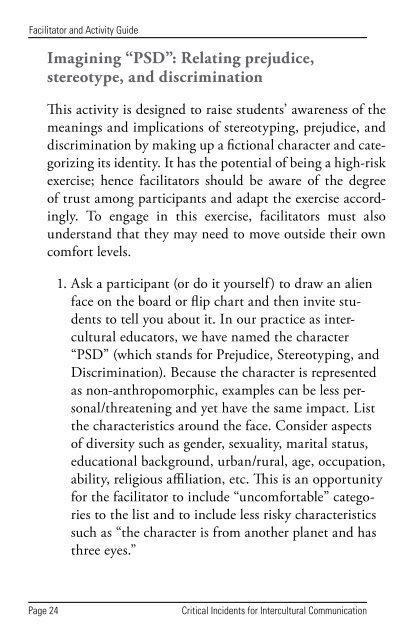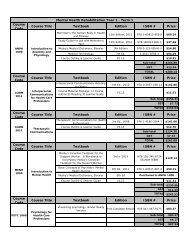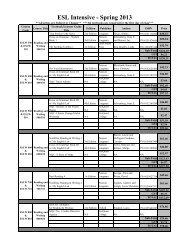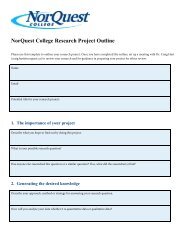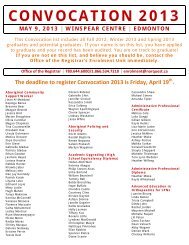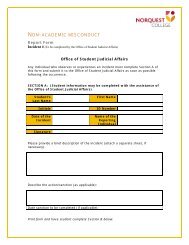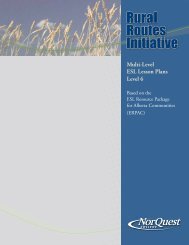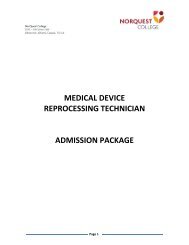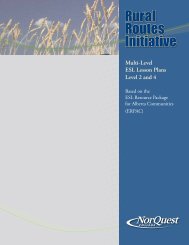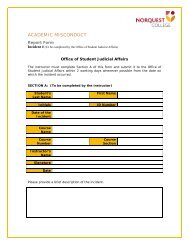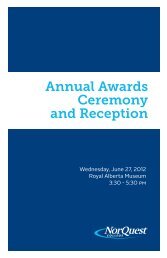Critical Incidents for Intercultural Communication - NorQuest College
Critical Incidents for Intercultural Communication - NorQuest College
Critical Incidents for Intercultural Communication - NorQuest College
- No tags were found...
You also want an ePaper? Increase the reach of your titles
YUMPU automatically turns print PDFs into web optimized ePapers that Google loves.
Facilitator and Activity GuideImagining “PSD”: Relating prejudice,stereotype, and discriminationThis activity is designed to raise students’ awareness of themeanings and implications of stereotyping, prejudice, anddiscrimination by making up a fictional character and categorizingits identity. It has the potential of being a high-riskexercise; hence facilitators should be aware of the degreeof trust among participants and adapt the exercise accordingly.To engage in this exercise, facilitators must alsounderstand that they may need to move outside their owncom<strong>for</strong>t levels.1. Ask a participant (or do it yourself) to draw an alienface on the board or flip chart and then invite studentsto tell you about it. In our practice as interculturaleducators, we have named the character“PSD” (which stands <strong>for</strong> Prejudice, Stereotyping, andDiscrimination). Because the character is representedas non-anthropomorphic, examples can be less personal/threateningand yet have the same impact. Listthe characteristics around the face. Consider aspectsof diversity such as gender, sexuality, marital status,educational background, urban/rural, age, occupation,ability, religious affiliation, etc. This is an opportunity<strong>for</strong> the facilitator to include “uncom<strong>for</strong>table” categoriesto the list and to include less risky characteristicssuch as “the character is from another planet and hasthree eyes.”Facilitator and Activity Guide2. Once the character has been described, stop and ask,“How do we know all this when we have never seenthe character be<strong>for</strong>e?” or “How do we know all thiswhen we have never met this character be<strong>for</strong>e?” Thenask, “What are we doing?” Someone is likely to say“prejudice.” If no one says it, then the facilitator canprovide the word. Explain prejudice by exploringits Latin root praejudicium meaning an opinion orjudgement <strong>for</strong>med without due examination. Hence,acts of prejudice can mean decision making on thebasis of incomplete in<strong>for</strong>mation or pre-judging. Thenask the participants, “Has anyone ever thought or saidsomething about you that was not true?” “Have youever thought or said something about someone elsethat wasn’t true, based on the person’s appearance/origin/sexualorientation?”3. The next step is to ask participants to think about thecharacter’s neighbourhood (or planet!) and pretendthat everyone who lives there is exactly the same (i.e.all the individuals who live on this planet have badbreath, are bad parents, etc). Then ask, “What are wedoing when we say this?” Stereotyping. You can makeuse of the questions in Step 2 to draw out participants’experiences with stereotyping, either when itwas applied to them or when they stereotyped someoneelse.Page 24<strong>Critical</strong> <strong>Incidents</strong> <strong>for</strong> <strong>Intercultural</strong> <strong>Communication</strong><strong>Critical</strong> <strong>Incidents</strong> <strong>for</strong> <strong>Intercultural</strong> <strong>Communication</strong> Page 25


